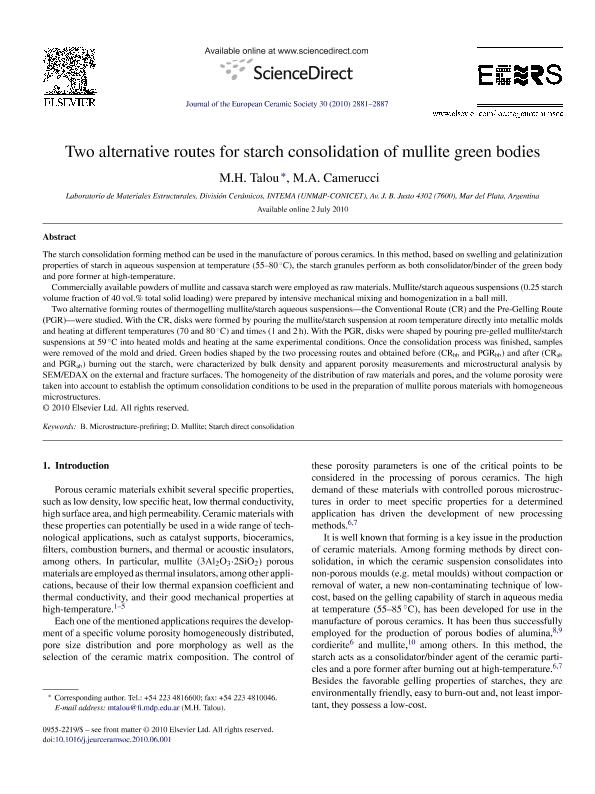Mostrar el registro sencillo del ítem
dc.contributor.author
Talou, Mariano Hernán

dc.contributor.author
Camerucci, Maria Andrea

dc.date.available
2018-08-16T15:21:34Z
dc.date.issued
2010-10
dc.identifier.citation
Talou, Mariano Hernán; Camerucci, Maria Andrea; Two alternative routes for starch consolidation of mullite green bodies; Elsevier; Journal of the European Ceramic Society; 30; 14; 10-2010; 2881-2887
dc.identifier.issn
0955-2219
dc.identifier.uri
http://hdl.handle.net/11336/55891
dc.description.abstract
The starch consolidation forming method can be used in the manufacture of porous ceramics. In this method, based on swelling and gelatinization properties of starch in aqueous suspension at temperature (55-80°C), the starch granules perform as both consolidator/binder of the green body and pore former at high-temperature.Commercially available powders of mullite and cassava starch were employed as raw materials. Mullite/starch aqueous suspensions (0.25 starch volume fraction of 40. vol.% total solid loading) were prepared by intensive mechanical mixing and homogenization in a ball mill.Two alternative forming routes of thermogelling mullite/starch aqueous suspensions-the Conventional Route (CR) and the Pre-Gelling Route (PGR)-were studied. With the CR, disks were formed by pouring the mullite/starch suspension at room temperature directly into metallic molds and heating at different temperatures (70 and 80°C) and times (1 and 2h). With the PGR, disks were shaped by pouring pre-gelled mullite/starch suspensions at 59°C into heated molds and heating at the same experimental conditions. Once the consolidation process was finished, samples were removed of the mold and dried. Green bodies shaped by the two processing routes and obtained before (CRbb and PGRbb) and after (CRab and PGRab) burning out the starch, were characterized by bulk density and apparent porosity measurements and microstructural analysis by SEM/EDAX on the external and fracture surfaces. The homogeneity of the distribution of raw materials and pores, and the volume porosity were taken into account to establish the optimum consolidation conditions to be used in the preparation of mullite porous materials with homogeneous microstructures.
dc.format
application/pdf
dc.language.iso
eng
dc.publisher
Elsevier

dc.rights
info:eu-repo/semantics/openAccess
dc.rights.uri
https://creativecommons.org/licenses/by-nc-nd/2.5/ar/
dc.subject
B. Microstructure-Prefiring
dc.subject
D. Mullite
dc.subject
Starch Direct Consolidation
dc.subject.classification
Recubrimientos y Películas

dc.subject.classification
Ingeniería de los Materiales

dc.subject.classification
INGENIERÍAS Y TECNOLOGÍAS

dc.title
Two alternative routes for starch consolidation of mullite green bodies
dc.type
info:eu-repo/semantics/article
dc.type
info:ar-repo/semantics/artículo
dc.type
info:eu-repo/semantics/publishedVersion
dc.date.updated
2018-08-13T17:22:34Z
dc.journal.volume
30
dc.journal.number
14
dc.journal.pagination
2881-2887
dc.journal.pais
Países Bajos

dc.journal.ciudad
Amsterdam
dc.description.fil
Fil: Talou, Mariano Hernán. Consejo Nacional de Investigaciones Científicas y Técnicas. Centro Científico Tecnológico Conicet - Mar del Plata. Instituto de Investigaciones en Ciencia y Tecnología de Materiales. Universidad Nacional de Mar del Plata. Facultad de Ingeniería. Instituto de Investigaciones en Ciencia y Tecnología de Materiales; Argentina
dc.description.fil
Fil: Camerucci, Maria Andrea. Consejo Nacional de Investigaciones Científicas y Técnicas. Centro Científico Tecnológico Conicet - Mar del Plata. Instituto de Investigaciones en Ciencia y Tecnología de Materiales. Universidad Nacional de Mar del Plata. Facultad de Ingeniería. Instituto de Investigaciones en Ciencia y Tecnología de Materiales; Argentina
dc.journal.title
Journal of the European Ceramic Society

dc.relation.alternativeid
info:eu-repo/semantics/altIdentifier/doi/http://dx.doi.org/10.1016/j.jeurceramsoc.2010.06.001
dc.relation.alternativeid
info:eu-repo/semantics/altIdentifier/url/https://www.sciencedirect.com/science/article/pii/S0955221910002797
Archivos asociados
